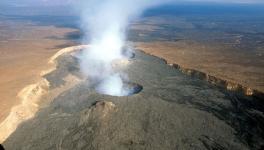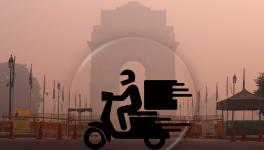Delhi Witnessed Lowest Air Pollution this Winter, says CSE Report
Representational use only.Image Courtesy:Wikimedia Commons
Patna/Delhi: In some good news for residents of Delhi who have been battling poor air quality, the level of air pollution was recorded lower this winter. In fact, winter in Delhi was the least polluted in the past five years, says a latest research report.
According to an analysis of winter air pollution levels by the Centre for Science and Environment (CSE), a New Delhi-based non-profit organisation, the city-wide winter average for Delhi stood at 160 microgrammes per cubic metre (µg/m³) for the October-January period, which is the lowest level recorded since wide-scale monitoring started in 2018-19. The PM2.5 level, computed by averaging monitoring data from 36 CAAQMS stations located in the city, was 17% lower compared to the seasonal average of the 2018-19 winter. Based on the subset of the 10 oldest stations, there is an improvement of almost 20%.
"This winter has been the cleanest in New Delhi-NCR since large-scale air quality monitoring started in 2018,” said Anumita Roychowdhury, executive director-research and advocacy, at CSE, in a release. Roychowdhury pointed out that a comprehensive analysis of PM2.5 trends during the entire winter season (October 2022-January 2023) in Delhi-NCR shows a “bending of the winter pollution curve and lowering of peak levels.”
“This improvement is a combined effect of meteorology and emergency action based on pollution forecasting. There was heavy and extended rainfall in the early phases of the season that prevented smog episodes from building up and also lowered the seasonal average. Despite the decline, Delhi continues to remain the most polluted among the cities and towns of NCR (National Capital Region). This downward trend will have to be sustained with much stronger action on vehicles, industry, waste burning, construction, solid fuel and biomass burning to meet the clean air standard,” says Roychowdhury.
The analysis shows that there were still 10 days of severe and severe-plus air quality and one four-day-long smog episode during this winter. In the larger NCR, seasonal averages varied considerably among the cities and towns, but high pollution episodes were synchronised despite large distances. Delhi and the neighbouring cities of Faridabad, Ghaziabad, Gurugram and Noida were relatively more polluted than other NCR towns, though not significantly. This is the challenge of this landlocked region that demands even stronger action,” says Avikal Somvanshi, senior programme manager, at Urban Lab, CSE.
This winter, 10 days had a city-wide average in the “severe” or worse AQI category, which is much lower compared to 24 such days in the previous winter and 33 in the 2018-19 winter. “This winter, only one smog episode was recorded from January 6-9, 2023. The average daily intensity of this smog stood at 287 µg/m³. This winter was the first in the last five years when both Diwali and late December (around Christmas) did not experience a smog episode.
However, the report further said that like the city-wide winter average for Delhi, the winter peak pollution level was found to be the lowest recorded since wide-scale monitoring started in 2018-19. The city-wide peak this year stood at 401 µg/m³ which was recorded on November 3, 2022. The peak PM2.5 24-hour value, computed by averaging monitoring data from 36 CAAQMS stations located in the city, was 26% lower compared to the highest recorded winter peak (546 µg/m³ in 2019-20 winter). The worst station level peak was 25% lower compared with the highest recorded station level winter peak (806 µg/m³ in the 2018-19 winter).
The total count of farm stubble fires reported this year from Punjab, Haryana and Delhi in October and November stood at 55,846, according to NASA’s VIIRS satellite and 12,158, according to its MODIS satellite. These are 36% and 40% lower than the figures for October-January in 2021-22. If the FRP (fire radiative power which is the measure of the intensity of fire) is taken into account in addition to the number of fires, it becomes clear that not only were the fires lesser in the count but also lower in intensity compared to the previous two years. The total FRP this October-January has been 373 kW and 199 kW, according to VIIRS and MODIS respectively. This is 43% and 49% lower than last year’s values, respectively.
As per the CSE report, “fires have been lower this October-January both in count and intensity compared to previous two seasons, but are marginally higher compared to 2019-20 season. Therefore, it can be argued that the spike seen in the fires since the pandemic started has ended and the situation has reverted to a pre-pandemic scenario. This is a relatively better scenario, but we are still far from attaining our clean air objectives.”
Similarly, this year, smoke from farm stubble fires contributed to PM2.5 levels in Delhi for 53 days, starting October 12 and ending on December 3, 2022. This is lesser than in the previous three years when the smoke intrusion was reported on 56 days, but it is higher than the 2018-19 winter figure of 48 days. The highest contribution this year was 34%, reported on November 3, 2022. But given the overall low PM2.5 levels this year, 34% contribution accounts for much less in terms of actual PM2.5 concentration in Delhi’s air. Therefore, it is critical to look also at the absolute mass of PM2.5 that got transported to the city from the fires.
But the CSE report said that in terms of absolute concentration, Delhi was the most polluted major city in NCR with a winter average of 160 µg/m3. Greater Noida with 143 µg/m3 was the next most polluted major city in NCR. Faridabad and Gurugram both registered 133 µg/m3 while Ghaziabad did marginally better with a winter average of 132 µg/m3. Noida was the least polluted major city with a winter average of 124 µg/m3.
Among the five big NCR cities, Ghaziabad registered the highest improvement in its winter PM2.5 level with a reduction of 23 per cent compared to the previous winter average. Noida (17%), Faridabad (12%) and Gurugram (6%) also registered improvements in air quality, but it worsened for Greater Noida (-3%).
Get the latest reports & analysis with people's perspective on Protests, movements & deep analytical videos, discussions of the current affairs in your Telegram app. Subscribe to NewsClick's Telegram channel & get Real-Time updates on stories, as they get published on our website.
























